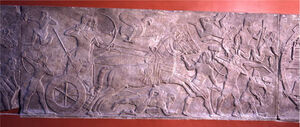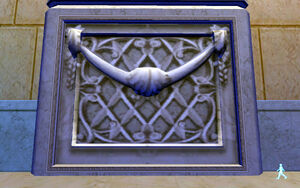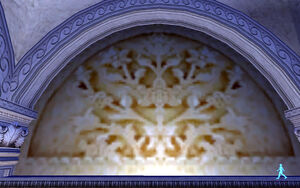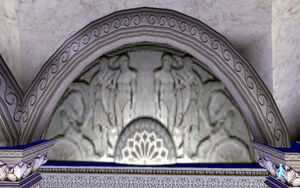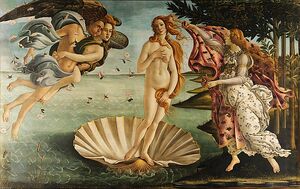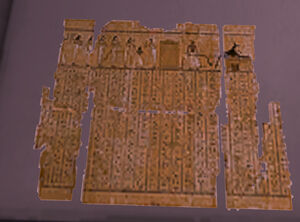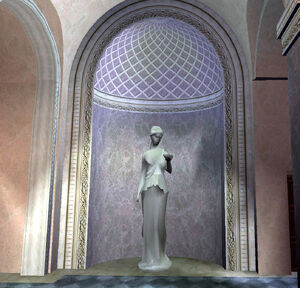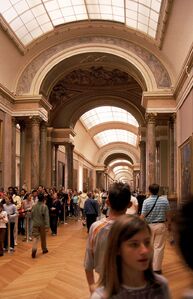This level is one of the largest of the game. It has many artworks. It was intended to play with stealth but you can also play without stealth. This level has three parts: Staircase, room with paintings and lasers and the room with lasers and guards.
Known references, first staircase[]
10.01 - The Barberini Ivory[]
- Made in: 525 or 550
- Name: The Barberini Ivory[1], named after Francesco Barberini[2]
- Current location: The Louvre
- Original: https://collections.louvre.fr/en/ark:/53355/cl010114082
10.02 - Bull statues[]
- Made in: 522 till 486 BC from the time of Darius I
- Name: Bull statues of the Apadana [3] or audience chamber of the palace of Darius in Susa. [4]
- Current location: The Louvre
- Original: https://collections.louvre.fr/en/ark:/53355/cl010170688
These are an example of art from the Achaemenid Empire (550 - 330 BC). The bull statues are now in the Louvre. More information here https://www.khanacademy.org/humanities/ancient-art-civilizations/ancient-near-east1/persian/v/bull-capital-susa.
10.03 - Relief of Itwesh[]
- Made in: 5th Dynasty, Egypt (2475-2345 BC)
- Name: Relief of Itwesh or Semenkhu-Ptah
- Current location: The Brooklyn Museum, USA
- Original: https://www.brooklynmuseum.org/opencollection/objects/116774
Itwesh, more officially called Semenkhu-Ptah, was an important royal official, according to the inscription on this relief fragment from his tomb. The image represents not the living Itwesh but one of his tomb statues. In Egyptian reliefs, living people are generally depicted with both shoulders in a frontal view, while images of statues show just one shoulder in profile. The full chin, receding (slightly retouched) hairline, and walking stick indicate that the statue of Itwesh shown in this relief portrayed him as a stout man in prosperous middle age.
10.04 - Stele of Nefertiti and a princess[]
This is a part of a house altar and it depicts queen Nefertiti (Neferneferuaten Nefertiti) and a child Meketaten (Neferneferuaten Meketaten) in mirror.
- Made in: 18th Dynasty, Egypt (1353-1334 BC)
- Name: House altar of Akhenaten and Nefertiti[5]
- Current location: Egyptian museum of Berlin
- Original: http://www.egyptian-museum-berlin.com/c52.php#n_hausaltar_01.jpg
It depicts the god Aten with his rays ending in ankhs, on the left side king Akhenaten Neferkheperure-waenre kissing his child and in front of them queen Nefertiti with two children Meketaten and Neferuneferuaten Ankhensenpaäten (or later when she was married with Tutankhamun: Ankhsenamun). The stele was made in the 18th Dynasty of Egypt (1549-1292 BC) during the reign of Akhenaten (1353-1334 BC). It shows a rather intimate scene (unlike the period before and after his reign) and is an example of Amarna art. It is now at the Egyptian Museum of Berlin.
10.05 - Greek Athletes[]
- Made in: around 500 BC
- Name: Kouros base with ball-players and wrestlers. [6]
- Current location: National Archaeological Museum in Athens
- Original: https://en.m.wikipedia.org/wiki/File:Late_archaic_relief.jpg
10.06 - Stele of Akhetaa[]
- Made in: 3th dynasty of Egypt, Old Kingdom
- Name: Akhetaa or Aa-akhti [7]
- Current location: The Louvre, France
- Original: https://collections.louvre.fr/en/ark:/53355/cl010010136
He was a high official during the reign of king Nebka, an obscure Pharaoh.
10.07 - Assyrian war scenery[]
The scenery consist of two parts. I Believe that both them are from the British Museum from the time of Ashurnazirpal II from Assyria.
left one:
- Made in: 865BC-860BC
- Name: Gypsum wall panel relief, of Ashurnazirpal II, Museum number 124546
- Current location: British museum
- Original: https://www.britishmuseum.org/collection/object/W_1849-0502-12
right one:
- Made in: 865BC-860BC
- Name: Gypsum wall panel relief of Ashurnazirpal II, Museum number 124551
- Current location: British museum
- Original: https://www.britishmuseum.org/collection/object/W_1849-1222-12
10.08 - Baptismal font[]
I found an old image from the Salon of the Caryatides from 1851, made by Fortuné Joseph Petiot-Groffier, where on display is a baptismal font. Sadly the object is not on display any more. So I can't get information about it. If you know something about it, let me know it.
Unknown references, first staircase[]
10.09 - Hermes figure[]
This thing is derived from a metalic disc with Hermes on it. I couldn't get the original. But I think it is Greek/Roman.
10.10 - Floor mosaic/pattern[]
Unknown floor mosaic, I don't think it is from the Louvre.
10.11 - Column with leaves and flowers[]
Unknown column.
10.12 - Unknown[]
There is still an unknown
10.13 - Flower scene[]
Also unknown. I think it's ivory.
10.14 - Relief with men on it[]
Unknown, didn't found on the internet.
Known references, room with paintings and lasers[]
10.15 - Stele of Nefertiabet[]
The stele is from princes Nefertiabet or Neferet-iabet (meaning Beautifull one of the east). She was the daughter of king Khufu or Cheops. Fun fact: it was also used in Tomb Raider IV in the level "Pharos, temple of Isis".
- Made in: 4th dynasty of Egypt.
- Name: Stele of Nefertiabet[8]
- Current location: Louvre Museum
- Original: https://collections.louvre.fr/en/ark:/53355/cl010005261
10.16 - Painting by Albrecht Altdorfer[]
- Creator: Albrecht Altdorfer (1480-1538)[9]
- Made in: 1537
- Name: Lot and his daughter
- Current location: Kunsthistorisches Museum, Vienna, Austria
- Original: https://www.wikiart.org/en/albrecht-altdorfer/lot-and-his-daughter-1537
More information:[10]
Notable events in his life include his journey with his uncle Abram (Abraham) and his flight from the destruction of Sodom and Gomorrah, during which Lot's wife became a pillar of salt, and Lot was made drunk and then raped by his daughters so that they could have children.
According to Ash [11], the daughters of Lot where expelled from Sodom and trying to get their father drunk so that they can reproduce, is a reference to the Nephilim.
10.17 - Painting by Willem Claesz Heda[]
- Creator: Willem Claesz Heda (1593/1594-1680/1682) [12]
- Made in: 1651
- Name: Still life with ham, mustard pot, bread, olives and roemer
- Current location: Liechtenstein Museum
- Original: https://commons.wikimedia.org/wiki/File:Willem_Claesz._Heda_-_Still-Life_-_WGA11242.jpg
10.18 - Painting by Sandro Botticelli[]
- Creator: Sandro Botticelli (1445-1510) [13]
- Made in: 1480
- Name: The Birth of Venus
- Current location: Uffizi Gallery, Florence, Italy
- Original: https://commons.wikimedia.org/wiki/File:Sandro_Botticelli_-_La_nascita_di_Venere_-_Google_Art_Project_-_edited.jpg
According to Ash [14], it is a reference to Lara Croft. She died at the end of TRIV, her memorial was in TRV and now she is born again.
10.19 - Painting by pieter Claesz[]
- Creator: Pieter Claesz (1597-1660) [15]
- Made in: 1635
- Name: Still-life with Wine Glass and Silver Bowl
- Current location: Gemäldegalerie, Berlin
- Original: https://www.wga.hu/frames-e.html?/html/c/claesz/roemer.html
10.20 - Painting by De La Morinière[]
- Creator: Mademoiselle De La Morinière (1807-1857) [16] [17]
- Made in: 1840
- Name: S.M. della Spina,Ponte a Mare”, torre Guelfa. Pisa 1840”
- Current location: Unknown but I think PALAZZO BLU.
- Original: https://palazzoblu.it/2020/05/il-diario-per-immagini-di-adele-una-giovane-francese-nella-pisa-dellottocento/
10.21 - Papyrus of Ani[]
- Made in: 19th dynasty, around 1250 BC
- Name: Papyrus of Ani[18]
- Current location: British Museum
- Original: https://www.britishmuseum.org/collection/object/Y_EA10470-32
Ani was a Theban scribe. Chapter 125 consist of three pages. Ani arrives in the hall of Maati or the double truth. Here he must confess to 42 gods. If you think that's a huge amount of gods, yes it is true. But the number 42 represent the administrative areas of ancient Egypt: 22 for Upper-Egypt and 20 for Lower-Egypt. To each of the god, Ani must speak in a negative way: I didn't commit murder. After this trial his hearth will be weighted on a scale before Osiris.[19]
10.22 - Papyrus MS1639[]
- Made in: 18th dynasty, 1500 BC
- Name: Papyrus MS1639, Book of the dead, The deceased befor the boat of Ra surmounted by wedjat eyes.
- Current Kontiki Museet, Oslo
- Original: https://www.schoyencollection.com/papyri-ostraca-collection/hieroglyphic/book-of-the-dead-ms1638
10.23 - Papyrus of Paheby[]
- Made in: Ptolemaïc period, 331-30 BC
- Name: Fragment of a book-of-the-dead beloning to Paheby, son of Ankhpakhered and Takhebyt
- Current Michael C. Carlos Museum
- Original: https://carlos.emory.edu/htdocs/ODYSSEY/EGYPT/bookofdeadLBL.html
10.24 - Runic Calendar on ivory[]
- Made in: 1500, Sweden
- Name: Calendar with weekdays, golden numbers, tabula signorum, solar circle and feast days.
- Current National Maritime Museum and the Royal Observatory, Greenwich.
- Original: https://www.schoyencollection.com/calendars-almanacs/medieval/ivory-book-calendar-ms-1577
10.25 - Greek Hoplite armoury[]
In the cabinet it displays a Greek Hoplite armoury.
Unknown references, room with paintings and lasers[]
10.26 - Coptic papyrus[]
Couldn't find it.
10.27 - Greek / Roman coins[]
Unknown Geek / Roman coins.
Known references, Room with lasers and guards[]
10.28 - Statue of Hebe[]
- Creator: Bertel Thorvaldsen (1770-1844) [20]
- Made in: 1816
- Name: Hebe
- Current location: Thorvaldsen Museum, Copenhagen, Denmark
- Original: https://commons.wikimedia.org/wiki/File:Hebe_-_Thorvaldsens_Museum_-_DSC08687.JPG
It depicts the goddess Hebe, the goddess of the youth. One of the many sons and daughters of Zeus. She can be recognised by the cup in her right hand, the cup is filled with ambrosia the food of the gods.
The background of the statue is the same as the background on the Pallas Athene statue[21]. Apparently it is a decoration that looks like the pattern of the seeds in a sunflower: the Fibonacci number[22], named after Leonardo de Pisa[23].
Unknown references, Room with lasers and guards[]
10.29 - Painting[]
It is a still life with a basket of oranges or apples. I couldn't find the original on the internet. It could be Auguste Laux.
Trivia[]
10.30 - Room with lasers and paintings[]
The room with lasers and paintings is based on the Grand Galerie or Galerie du Bord de L'Eau from the Louvre. This room is the largest of the Louvre and contains Italian paintings. It was constructed in 1595 and completed in 1607. Hubert Robert, the first keeper of paintings improved the lighting of the gallery between 1805 and 1810 by Percier and Fontaine. They created nine subdvisions of the long room, separeated by groups of columns arranged in the manner of Venetian windows.[24]
10.31 - Room with guards and lasers[]
This overview reminds me of a particular area of the louvre. This is called: Salle des Caryatides[25]
10.32 - Shooting pots to pieces[]
Lara can shoot the pots.to pieces. She can also shoot at some cabinets.
Notes and references[]
- ↑ https://en.wikipedia.org/wiki/Barberini_ivory
- ↑ https://en.wikipedia.org/wiki/Francesco_Barberini_(1597%E2%80%931679)
- ↑ https://en.wikipedia.org/wiki/Apadana
- ↑ https://en.wikipedia.org/wiki/Palace_of_Darius_in_Susa
- ↑ https://en.wikipedia.org/wiki/Nefertiti_Bust
- ↑ https://en.wikipedia.org/wiki/Kouros
- ↑ https://en.wikipedia.org/wiki/Akhetaa
- ↑ https://en.wikipedia.org/wiki/Nefertiabet
- ↑ https://en.wikipedia.org/wiki/Albrecht_Altdorfer
- ↑ https://en.wikipedia.org/wiki/Lot_(biblical_person)
- ↑ https://www.youtube.com/watch?v=O2wQUDESNbg, at 04:39 till 04:55
- ↑ https://en.wikipedia.org/wiki/Willem_Claesz._Heda
- ↑ https://en.wikipedia.org/wiki/Sandro_Botticelli
- ↑ https://www.youtube.com/watch?v=O2wQUDESNbg, at 05:27 till 05:44
- ↑ https://en.wikipedia.org/wiki/Pieter_Claesz
- ↑ https://commons.wikimedia.org/wiki/Category:Mademoiselle_de_la_Morini%C3%A8re
- ↑ https://palazzoblu.it/2020/05/il-diario-per-immagini-di-adele-una-giovane-francese-nella-pisa-dellottocento/
- ↑ https://en.wikipedia.org/wiki/Papyrus_of_Ani
- ↑ https://zsitchinindex.wordpress.com/2016/03/15/the-book-of-the-dead-papyrus-of-ani/10/
- ↑ https://en.wikipedia.org/wiki/Bertel_Thorvaldsen
- ↑ https://commons.wikimedia.org/wiki/File:Pallas_Athena_Velletri_Louvre.jpg
- ↑ https://en.wikipedia.org/wiki/Fibonacci_number
- ↑ https://en.wikipedia.org/wiki/Fibonacci
- ↑ https://en.wikipedia.org/wiki/Grande_Galerie
- ↑ https://commons.wikimedia.org/wiki/Category:Salle_des_Caryatides_(Louvre)














